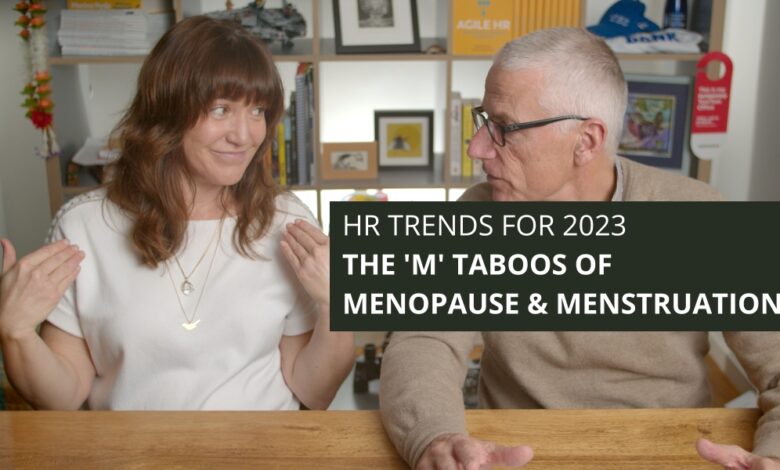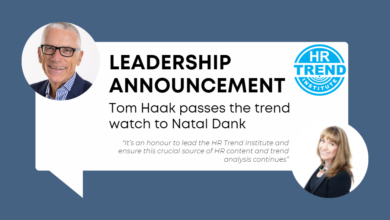HR Trends 2023 – Menopause & Menstruation Taboos

At an HR conference last week, I talked about one of the top HR trends, Tom Haak and I have cited for 2023 – the topics of menopause and menstruation in the workplace or, as we’ve called them, the ‘M’ taboos.
The presentation met with spontaneous applause. Menopause and menstruation are facts of life for many people, but we don’t talk about them, at least not in the workplace.
At the end of the conference, some Millennials and Gen-Z people thanked me for speaking openly about these topics, and this surprised me as I foolishly assumed that for the younger generations, discussing these subjects had become a non-issue. However, the silence, stigma and lack of rapport continue apparently.
Menstruation impacts about half of the workforce. However, statistics show that 74% of people who experience menstruation feel it’s necessary to hide period products at work, and 60% feel uncomfortable discussing the topic with colleagues or managers.
During the conference, a young person working with me told me they were experiencing bad period cramps. Rather than just glibly saying, “Oh, that’s a shame, I’m sorry to hear that”, assuming we should both ignore it, I suggested they lie down somewhere for a while to see if it helped. Sure enough, after a short break, they were back on the job feeling much more capable and mentally able.
Symptoms can be much more severe, even debilitating and worse still, can be a sign of more serious underlying conditions. If someone ignores the initial indications because they seem like ‘women’s problems’ and just pushes through, they might not seek a medical diagnosis.
Awareness and education are essential. Most of the men I spoke with at the conference simply didn’t have the information to engage in an open and objective conversation about these topics.
Many managers admit that a lack of knowledge has prevented them from discussing menstruation and menopause in the past and is another example of where we are not adequately preparing managers.
Watch a short 1 minute summary of this trend here.
Why cite menopause and menstruation as a trend in 2023?
We cited menopause and menstruation as an HR trend in 2023 because policies in the UK and countries in the EU, particularly, are making definite inroads. Many organisations like the National Trust, Diageo, BBC, AstraZeneca, Tesco and Lloyds Bank are implementing menopause-related policies and education. Also, we’ve received a lot of positive endorsements and support directly on the topics of menopause and menstruation.
In addition, we’re seeing more discussion around menstrual leave and the need to talk about menstruation and have period products available. Scotland has even made period products free to tackle period poverty.
This week we ran a LinkedIn Live webinar on our top 9 HR trends for 2023, including menopause and menstruation in the workplace. Reactions were overwhelmingly positive, and we were encouraged that many men joined the conversation, which is crucial to seeing change happen.
Someone highlighted the usefulness of remote work and flexible working hour policies. Not only do these arrangements help parents and night owls, but they’re also a blessing for people dealing with period pain, hot flashes or sleep deprivation.
However, it was also clear that there’s still a long way to go and that this is an essential topic on which to focus. As one participant commented, “Why should women have to silently suffer or feel ashamed of things that are naturally occurring phases of life?”.
We also hear the rallying cry of the need to do more.
Disappointingly, the UK government recently rejected a proposal that would have recognised menopausal workplace rights. The principal complaint was that it discriminates against men with long-term medical conditions. This objection plays on the common fallacy that increased rights for one group mean diminished rights for others, which is nonsense. Allowances for the effects of long-term illnesses should be part of any adequately comprehensive and authentic policy on wellbeing.
A particularly disappointing part of this unfavourable decision was the refusal to pilot menopausal leave in the UK. We see this as a huge missed opportunity to take an experimental, evidence-based approach to discover what works and what doesn’t.
Don’t let this stop you in your organisation though. Prototyping is how we’d suggest you instigate such a program and make progress in your workplace. Get data by running short-term experiments where you test a policy or a specific benefit and compile evidence of what is likely to have a positive impact.
Fun ‘M’ fact – what’s generally referred to as menopause is, in fact, perimenopause, and menopause is a single day that marks the end of perimenopause. Who knew?
What personal action can you take around menopause and menstruation?
I recently hit the start of perimenopause, which significantly impacted my work until I made positive lifestyle changes to help [ed: with support from her amazing but humble partner]. Accessing information about what was happening to my body was transformative. Once I understood the science behind what was going on, I felt better and more able to make choices to help myself.
Louise Newson has a great book “Preparing for the Perimenopause and Menopause” and a handy website. In fact, I used her symptoms list to start a dialogue with my local GP.
Other highly recommended resources include:
- ‘Everything you need to know about menopause (but were too afraid to ask)’ by Kate Muir.
- ‘The Secret Female Hormone: How Testosterone Replacement Can Change Your Life’ by Dr Kathy C Maupin.
- ‘Perimenopause Power: Navigating your hormones on the journey to menopause’ by Masie Hill.
- ‘Period power’ by Masie Hill.
- Davina McCall’s Channel 4 documentary ‘Sex, Myths and the Menopause’.
To paraphrase another contributor, ‘I experienced brain fog and emotional swings due to hormonal fluctuations that impacted my performance. Once I understood what was happening, I could source natural remedies and be back on form within a month or two. But no one told me about this or warned me to watch out for the signs. Why did I have to figure it out on my own?’
What action can organisations take around menopause and menstruation?
Women my age are the fastest-growing demographic in the workplace, and many of us also hold important senior roles vital to workplace diversity. Not only are there potential impacts on productivity, but many people of this demographic end up with little choice but to leave a role, and menopause-related issues can create barriers to a return to work. Apart from the human aspect, this can represent a significant business impact for organisations.
If we want to keep this valuable resource of (often older) women in senior roles in the workplace, we must break the ‘M’ taboos.
What can we do to address menopause and menstruation in the workplace?
Practical examples of how we can achieve more open discussions on menstruation and menopause include:
- Consider introducing information sessions and awareness campaigns.
- Get managers ready and able to discuss menstruation or menopause with their team through training and support.
- Update health and wellbeing policies to reflect the need to discuss and support people openly during menstruation or menopause.
- Provide free period products in workplace toilets.
- Consider the introduction of menstrual or menopause leave, allowing people to stay home when experiencing period pain or menopause symptoms.
- One organisation we know of has a WebEx space dedicated to people experiencing menopause/perimenopause to provide mutual support.
- Another company has a way for people to record their additional needs and reasonable adjustments for their managers. This information acts as a sort of personal user manual, so they don’t need to share this information again following a change of role or manager.
Have senior female leaders share their own experiences.
This is a perfect application for design thinking. In particular, techniques like empathy mapping can help is a great way to identify who in your organisation is affected and what they need. If you’re not familiar with Design Thinking or haven’t use it in an HR context checkout this article. Also, checkout our Agile HR Design Thinking Sprint program.
Menopause, Menstruation and the Future
As with any controversial topic, progress starts with creating an open public dialogue. We’ve focussed on menopause and menstruation here, but other related areas of wellbeing need to be addressed, too, such as the impact of miscarriages.
So far, our feedback suggests that most people are glad we are finally discussing these issues. We must continue down this path because, contrary to what some might say, the evidence is that addressing the lack of support and rights for one group enhances the wellbeing of all.
As usual we’d love to hear from you in the comments below. Is something important you think we missed? Do you have an experience of your own to share? Is there an idea you’d like to share? Please let us know.
The ‘M’ taboos is just one of 9 top HR trends we’ve identified for 2023. You can watch Natal Dank and Tom Haak discussing all the trends here.







